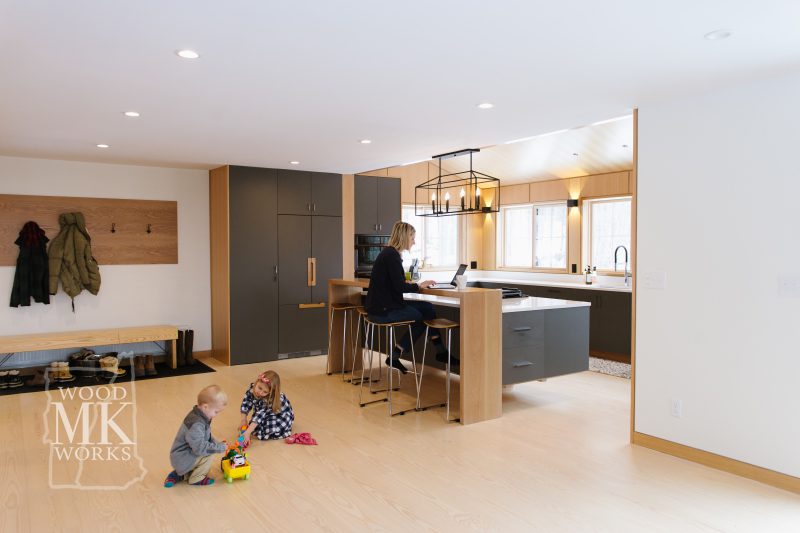3 Ways to Modernize Custom Cabinets
April 15, 2020
Sponsored Content
Text by Kristin Amico Photography by Katie Noble
 The kitchen is the heartbeat of a home—a place to do homework, savor dinners with loved ones, and lazily lounge on the weekend over a pot of coffee. Today, that’s even more true as families spend more time at home. All that together time creates family memories, but it also creates wear and tear in high-traffic spaces. It may be time to modernize custom cabinets in the kitchen or for updates to other well-worn areas to craft an environment that feels personal while being highly functional.
The kitchen is the heartbeat of a home—a place to do homework, savor dinners with loved ones, and lazily lounge on the weekend over a pot of coffee. Today, that’s even more true as families spend more time at home. All that together time creates family memories, but it also creates wear and tear in high-traffic spaces. It may be time to modernize custom cabinets in the kitchen or for updates to other well-worn areas to craft an environment that feels personal while being highly functional.
“The kitchen is the biggest focus, whether remodeling historic homes or planning a new build, and cabinets are the backbone of the room,” explains Matt Knittle, owner of MK Wood Works and an experienced cabinet maker with more than 20 years of experience creating custom work for clients across New England.
“Kitchen cabinets need to withstand everyday use while looking elegant,” he adds. These workhorses are also the easiest way to freshen up a kitchen. Here’s how Knittle advises meshing master craftsmanship with modern elements for a room that wows.
Shake up classic style
Shaker cabinetry is a mainstay of traditional New England kitchens. The religious group who fled England for Colonial America in the eighteenth century were renowned craftspeople who excelled at simple, utilitarian designs built to last for generations. Today, that style remains most visible in kitchens where the signature framed door with a flat panel insert is ubiquitous in both 200-year-old homes and renovated urban condos. But just because it’s classic, doesn’t mean that it can’t be updated.
Working with a custom woodworker lets you get creative and retain some traditional elements while putting a more modern touch on the busiest room in the house.
“Play with contrasts by mixing styles and textures to achieve more depth and visual interest,” advises Knittle. He offers a few ideas to get started.
Use a combination of traditional framed cabinets alongside sleek, frameless doors and drawer fronts throughout the kitchen or any other room where storage is needed.
Alternately, you can opt to add touches of texture including grooved paneling, glass inserts to showcase treasures stored inside cabinets, or multiple types of woods with contrasting grains.
To mix and match while still maintaining a cohesive feel, be deliberate. For example, choose to have framed cabinets on the lower level only, or alternately, create one large wall of flat-front cabinets, while showcasing textured or framed varieties in a small area, like a kitchen island.
Add details inside and out
“Why not have the inside of your drawers and cabinets look just as stunning as the outside?” That’s the question Knittle wants homeowners to consider when working with their designer and builders.
From a purely aesthetic standpoint, the classic dovetail joint can be made even prettier with contrasting woods or stain colors providing a pop of elegance in an unexpected place.
When it comes to form and function, there are interior hardware choices that not only look good, but will help keep the kitchen tidy, too. Consider drawer slides that are more durable than a decade ago and created to look like part of the drawer, as opposed to clunky pieces of metal. In addition, custom cabinet makers also have a wide range of organizational hardware to choose from for creating neat and orderly drawers. The minimalist-looking storage systems provide easy access to everything from large canisters to utensils—removing clutter from the countertop in a way that would make even Marie Kondo proud.
Opt for modern materials
While more homeowners embrace manmade materials on the outside of the house or on more durable surfaces like floors, they’ve been slow to adopt these high-tech composites for cabinets or other home surfaces.
“Laminates don’t get much attention when it comes to cabinetry, but contemporary versions are stylish, wear-resistant, and offer a life expectancy that can rival natural wood,” Knittle explains.
What’s the difference? While solid wood has been used across New England for centuries, the weather makes it swell during humid summer months and shrink in the winter—that’s why doors often stick or don’t close tightly. Newer materials including laminates and veneers are exceptional choices for the area because they remain uniform in size regardless of weather and are largely water resistant.
“These aren’t the budget-level options from twenty years ago,” Knittle says. “Today’s laminate choices can be easily customized and finished with the same precision and high-quality look that you expect from natural hardwood and can be used for more dramatic design effect.”
Ultimately, Knittle says everyone, from a homeowner in rural Vermont to a Brownstone dweller in Boston, should feel comfortable experimenting with modern cabinetry in their home.

MK Wood Works, Enfield, N.H.
Share
![NEH-Logo_Black[1] NEH-Logo_Black[1]](https://b2915716.smushcdn.com/2915716/wp-content/uploads/2022/08/NEH-Logo_Black1-300x162.jpg?lossy=1&strip=1&webp=1)















You must be logged in to post a comment.